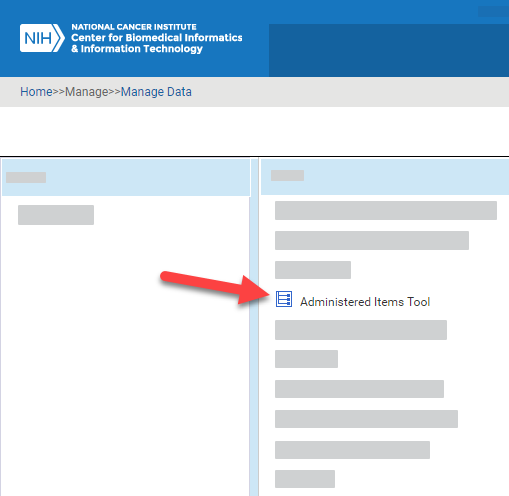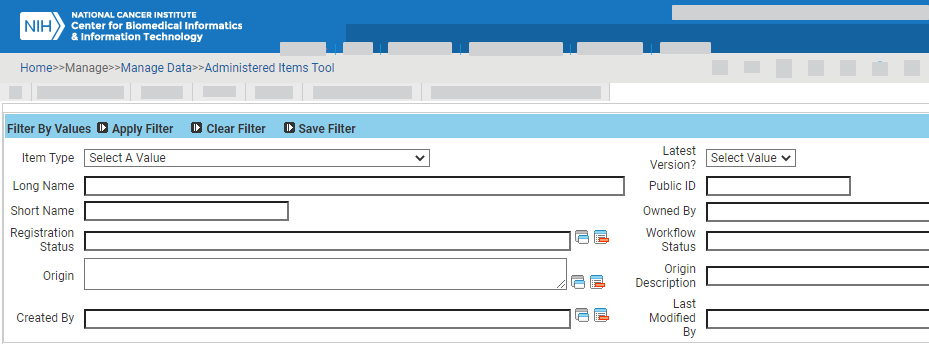When you search for administered items in OneData, keep in mind the following points:
- CDEs follow the ISO/IEC 11179 standard, so you can search for data elements using ISO/IEC 11179-based attributes.
- For each field, the default is all values. For example, in the Latest Version field, the default behavior returns all versions.
- Searches are not case sensitive. Searches for
Geneandgenereturn the same results. - In any editable text field, enter a search string, complete or partial. This does not apply to numeric fields such as Public ID.
- In any editable text field, you can use a percent sign (%) as a wildcard. For examples, refer to Using Wildcards.
- For some fields, you can adjust the search scope (with options such as IS NULL, IS NOT NULL, NOT LIKE, Exact Phrase Match, All Of The Words, or One Of The Words) by clicking the Advanced Filter icon.
- The system processes search criteria as AND statements, so the results include only items that fulfill all the criteria.
- To reset a list of values, click the Clear Values icon next to that list.
- If you clear a field, or if you leave a field at its default setting, the system does not limit the search by that criterion.
- You can specify the number of results returned: Type a number in the Number of Rows field and press <Enter>.
- When you remove or change search criteria, the system does not update search results until you click Apply Filter again.
To perform a search:
Log in as described in Logging In. The home page appears, with objects you have specified as favorites in the Favorites panel (if any).
From the Manage menu, select Manage Data. The Manage Data page appears.
Select Administered Items Tool. The Administered Items Tool appears. (For instructions on adding this page to your favorites, refer to Managing Your Favorites.)
Specify one or more search criteria, as described in the following table:
Field Instructions Item Type Select the type of registered administered item. Latest Version Select one of the following options: - To search for the latest version of an item, select Yes.
- To search for all versions except the latest version, select No.
As in all fields, the default behavior returns all versions.
Long Name Type all or part of the long name for an item. Public ID Specify the full numeric value for a single public ID. (You cannot use wildcards in numeric fields.) Short Name Type all or part of the short name for an item. Owned By Select one or more contexts. Owning contexts have the privilege to edit and update an item. Registration Status Select one or more registration statuses. For details, refer to Registration Status. Workflow Status Select one or more workflow statuses. For details, refer to Workflow Status. Origin Select one or more sources (document, project, discipline, or model). Origin Description Type all or part of the origin description an item. Created By Select the person who created an item. You can select one or more people. Last Modified By Select the person who last modified an item. You can select one or more people. In the fields that have a Select a Value icon, you can select one or more values. Click the Select a Value icon next to the field. A Reference Data Panel appears.
- To select one value: Click the value name. The value name appears in the field.
- To select one or more values: Click the checkbox for each row you want to include. Click Set Values. The field indicates how many values you have set.
For date criteria, click the Audit Columns icon and specify dates as described in the following table:
Field Instructions Date Created Click the calendar icon and select the date on which the item was created. Date Last Modified Click the calendar icon and select the date on which the item was last modified. To adjust search scope, click the Advanced Filter icon and consider the following options:
The list to the left of each date field allows you to search for items later than (>), earlier than (<), and/or equal to the date you specify.
- The list to the right of each date field allows you to specify whether the date field is NULL or NOT NULL.
- The check box below each date field allows you to specify a date range.
- You can also create your own query to search, by specifying an explicit "where" clause. Click the Advanced Filter icon. Under Filter Options, select a column and then click >>. The name of the selected column appears in the text box. Complete the query string. (For example, if your query string is "a.CURRNT_VER_IND=1" when you click Apply Filter, the system returns all items of the latest version.)
If necessary, you can specify additional criteria for finding items using one of the "Child Filter" options in the lower part of the search page. The system filters for items that match details specified in the selected child filter. For details, click one of the following links:
Click Apply Filter. The system lists all items that match your criteria. You can sort columns by clicking the column headers and selecting one of the choices: Ascending, Descending, Clear Sort, or New Sort.



